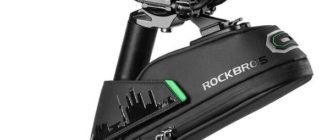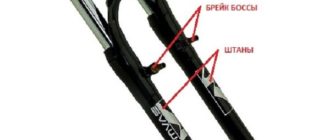Many people underestimate the importance of the bicycle bell, considering it a completely unnecessary archaism from the past. But today, with the rise of bike lanes in big cities, the number of cyclists and pedestrians on them has increased many times over. And in such conditions, when many pedestrians are not in their lane, an audible alert will be very helpful.
Today we’re going to talk about what a bicycle horn is called, as well as talk about the varieties of audible alerts that exist for two-wheeled vehicles, and, of course, tell you why a bicycle horn is considered a very useful accessory.
What is a bicycle horn
In the broadest sense of the word, a bicycle horn is a device that beeps when the corresponding lever is actuated. Today, cyclists can use electric devices, pneumatic horns and manual horns. Each type of horn differs in its respective operating principle and sound power.
The evolution of bicycle equipment has come a long way from classic bells to electric devices that can produce a variety of sounds and even melodies. Typically, modern models of bicycle horns work on the principle of pressing – a lever is squeezed and released, which in turn straightens out and strikes the bell.
Bicycle horn – this is a more solid device, which produces a more powerful sound with a volume up to 120 decibels. Such devices work on the principle of a pump with compressed air.
Based on the power and principle of operation, you should choose a particular accessory, which serves to give a sound signal. Of course, if this device is necessary to warn other road users on the pedestrian and bicycle paths, you can be limited to the most primitive device, which will produce an audible sound. You should not abuse the power of a bicycle bell – most people will be greatly frightened when they hear a sudden and very loud sound.
Do you have to use a bicycle bell?
There is no clear direction in the traffic code regarding the use of a buzzer on the road. However, there are clear rules governing the technical condition of two-wheeled vehicles that have the right to ride on public roads.
According to them, the bicycle must have serviceable brakes, handlebars and sound signal, be equipped with reflective elements and lighting devices. Accordingly, without a bicycle bell, we have no right to ride on the roads. In practice, of course, things work differently. Moreover, the vast majority of bicycle models are sold without a horn, a bell, or any other device that gives an audible signal.
So having a device that makes a warning sound is a purely individual decision. In particular, if you regularly ride on bike paths, where moms with strollers and children, people with dogs and just small companies – the presence of a sound signal will be very handy. You don’t have to yell, “Hey, move aside!” every time. And going around every person all the time is not the most convenient action.
To make the right choice, we recommend reading about the classification of bicycle horns and how they work.
Types of bike horns
Let’s start with the most extensive category – electric devices. Such a device works from normal batteries, which are placed inside the case. The electric horn is mounted on the handlebars of the bicycle – in the middle, on the left or on the right (as convenient for the cyclist). The working part of the electric device through the wire is connected to a button, which starts the mechanism of action.
The electric horn kit includes the following elements:
- audio machine;
- fixture for the buzzer;
- wire;
- button;
- fixing for the button.
The most successful place to place the device is the central part of the handlebar, next to the grips. Thanks to this location, the cyclist will be able to press the button at any time, without distracting from the movement.
The advantages of the electric device:
- the simplest installation;
- good hearing (the power of the sound signal reaches 105 dB);
- compact size of the device;
- universal design: the device looks harmoniously on road bikes, and on stylish mountain bikes from the same Land Rover, for example.
There are also disadvantages:
- extremely sharp and specific sound, which is unlikely to be pleasant for pedestrians, and the cyclist himself;
- the electric horn is not resistant to mechanical damage (this means that the probability of its breakage if the handlebar is dropped is extremely high);
- unreliability of plastic fasteners.
There are many varieties of electric horns for bicycles today. There are devices that emit a standard “bi-bee” when the button is pressed, there are devices that mimic the sound of a car alarm, and there are horns with a built phono.
The next category of bicycle sound devices are air horns, which in turn are divided into air horns and klaxons. Such devices work without batteries, are characterized by ease of use and installation. In addition, the beep they emit is slightly inferior to its electric competitor.
A pneumatic horn consists of the following components:
- air reservoir;
- curved tube;
- transit hose;
- nipple for pumping air;
- release button;
- fasteners.
The air in the corresponding chamber is under pressure, its pumping is carried out through the nipple, and the tank can be filled with an ordinary pump for pumping up the wheels.
The principle of operation of the pneumatic signal:
- Lower the cap on the nipple. The horn thus assumes a non-operational position.
- Press the protruding part of the cap, thereby lowering the spool. This creates a vacuum, pushing air out of the tank.
- The air flows through the transit hose into the curved tube, where it vibrates at a certain frequency.
- As soon as the edges of the cover are released, the spool returns to its original position and stops releasing air.
The pneumatic spool makes quite a sharp sound, but it does not hit your ears as hard as it does with an electric device. Such a device is suitable for sound alerting pedestrians, other cyclists and even motorists.
The disadvantages of pneumatics – the rapid release of air from the bottle and the absolute dependence on the state of the nipple (if it is broken, the horn will not work). And one more small nuance – it is aesthetic compatibility. Pneumatic horn looks great on cruisers, choppers, some road models and lightweight city-bikes. It is unlikely to fit as harmoniously into the exterior of mountain bikes, road bikes and hybrids.
The klaxon is essentially the same pneumatics, but more primitively arranged. The simplest model is a klaxon with direct air output. The principle of operation does not change from this: air under pressure passes through a tube and creates a wave of a certain frequency. This sound is perceived by the human ear more quietly – pedestrians and other road users react to it without irritation. The construction of the klaxon consists of a straight or shaped tube, a rubber bulb and a rigid mounting on the steering wheel.
The advantages of such a device for the sound signal are obvious:
- Simple design, which breaks down in extremely rare cases.
- Compact dimensions.
- Pleasant to the human ear sound, but at the same time loud enough.
- The original retro style.
Ironically, it is the last plus that often becomes a minus. The fact is that the klaxon fits perfectly into the exterior of urban models and retro bikes, choppers and some cruisers. But on bikes that have even the slightest hint of sports design, klaxon will look comical.
What’s better: a bell or a horn
In some countries, riding a bicycle that is not equipped with a device that emits a buzzer is prohibited. On our roads bikes with bells or horns – a rarity. However, if you decide to equip your bike with a similar device, it is worth to decide on the choice. In this case, you should be guided by the rules of operation:
- On quiet routes, use devices that emit a calmer and more familiar sound.
- On noisy and busy sections of the road to use devices that emit a sharp, but not very annoying sound.
Accordingly, it is up to you to decide what is better to use: a buzzer or a bell. In any case, among pneumatic devices you can find quite a few models that will cope with the task.
Recommendations for selection
The use of a device for sound notification is mandatory if you ride on the busy streets of the city or every weekend get out to the nearest park, where pensioners, families with children, people with pets and the same cyclists have a rest. Having a bike buzzer or bell has a whole range of benefits:
- An unobtrusive reminder of your presence to other road users.
- The ability to develop a decent speed on bike lanes by making a cheerful sound, thereby clearing the way.
- You will have a quiet conversation with traffic police officers who may ask you about having a bicycle bell.
Now that we know what tasks should cope with the appropriate device, you can proceed to the selection of the most appropriate device. The simplest option is to buy a mechanical bell. It is such accessories are equipped with the most budget models. But the mechanics can not make a loud sound. In addition, the simplest mechanisms refuse to work in rain and frost.
For riding in the big city you need a more powerful signal. An ordinary klaxon effectively copes with this task. But in this case, you should consider the stylistic combination. If you have a dynamic mountain model, it is better to look at electric devices for the sound alert.
Conclusion
The use of a bicycle bell is quite justified in large cities and places with large crowds of people. Today, the range of appropriate devices allows you to choose the most appropriate option in accordance with the overall style of the bicycle and the power of the sound emitted.









